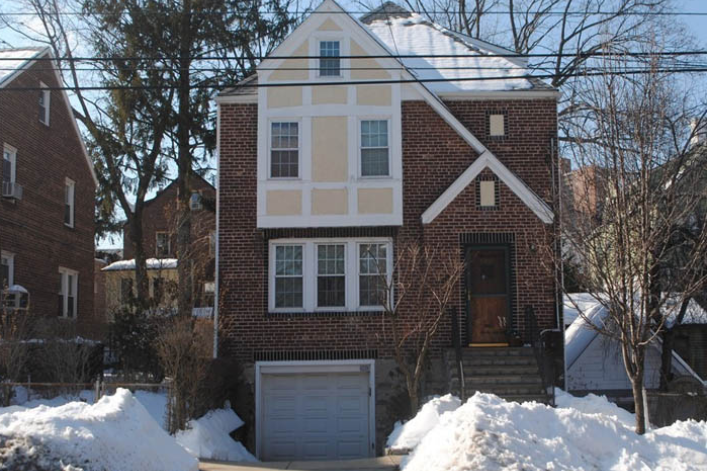A first-time buyer's tips for house-hunting without a broker

For many buyers, enlisting the help of a broker who can find properties that match your requirements and make appointments for you to see them is a no brainer, since the seller pays this person’s commission. So why not take advantage of free expertise? But in the hunt for my first home—ideally a house in the Bronx for about $400,000—I decided to do my own legwork, researching the neighborhoods I’m interested in, scheduling my own showings, and then reassessing when I’m close to making an offer.
Since I’m on a limited budget, I also thought that if I ended up representing myself through the whole process, I might be able to bargain a little harder and shave a few thousand dollars off the purchase price, since the seller wouldn’t have to pay my agent’s fee. Finally, I’m not in a huge hurry to buy. I don’t want to deal with any pressure from an agent while I get a feel for several different neighborhoods. After all, the agent wants you to buy a house as soon as possible, whereas I want to buy a house when I am good and ready.
Here, what I’ve learned so far about searching without an agent:
Getting started
There was nothing particularly creative about the way I started. You can find hundreds if not thousands of listings online that are searchable based on any number of criteria. Pretty quickly, you'll begin to decipher which may be promising listings given some clues: How many photos are available, how readable the description is and whether the price is at least in line with similar nearby properties are all good indicators as to the viability of the listing. Any doubts can be resolved with a quick call to the listing agent.
A major factor for me in locating a suitable house was the time I would spend commuting. I basically drew a line across the middle of the Bronx, from east to west, and then concentrated on two-family homes south of this line and near train stations. I had lived in some of these areas before, so I had general ideas about the parts I preferred.
Taking a drive-by look
Armed with a sheaf of listings I had printed out, I drove to the South Bronx with a friend on a Monday morning. At this point in the search, my priority was not seeing the space inside the homes, but rather seeing if the surrounding neighborhoods were places I would be willing to live. What were the houses like? How dense was the foot traffic? We even did the Seamless test in several neighborhoods —opening Seamless to see how many types of food you can get delivered to a particular address. In short, at this stage I was looking for the livability of the neighborhoods while doing a once over of the types of properties available.
We pulled up to the first house, a brownstone in Mott Haven. As long as you looked at it with blinders, it was perfect: three stories, 17 feet wide and in good condition. The neighboring houses were built in a similar style with conditions running the gamut from perfectly pristine to crack-den chic.
Here’s what didn’t look great: The street was flanked by housing projects. One, maybe two blocks, of nice row houses and then projects as far as you could see.
I’m not going to get into any personal views on projects except to say, that unless the city did a complete about turn with its housing agenda, those projects are not going anywhere any time soon. In some neighborhoods, the presence of projects hasn’t prevented them from improving in terms of rising average incomes, rising academic achievement and other barometers of upward mobility. But in areas such as Brownsville, Brooklyn and East Harlem in Manhattan, neighborhoods with a concentration of public housing similar to Mott Haven, property values have proven to be resistant to significant appreciation and all three of these areas struggle with high rates of unemployment. I want to be involved with my neighborhood and hopefully contribute to social progress but it concerns me that public housing may create a very static dynamic that even the best policies and intentions would be difficult to change.
We moved on to the next house. From the outside it looked huge, so I got out of the car to get a better look. An airplane roared overhead. And then another. And another. The house sat right below a flight path of planes leaving LaGuardia.
Unless you are an aviation enthusiast who likes the feel of permanently camping at the edge of a runway, this house is not for you.
We saw a couple more houses that day, all of which I could rule out without even going inside based on the characteristics of the surrounding neighborhoods.
A new angle
A week later, I tried a new angle of attack. I had seen a listing online that looked promising just northeast of Yankee Stadium and decided to take the train up and then walk by it and any other houses nearby. Of course, walking around in the cold, feeling out neighborhoods is no one’s idea of fun, so I went alone.
Walking instead of driving worked better. The first time, driving, I had covered more ground, but my attention was split between the road and the houses. I couldn’t always set my own speed or go whatever direction I wanted. Walking gave me the chance to see for sale signs that I might have missed otherwise. In a place as dense as New York City, walking probably makes the most sense.
I found a tree-lined street about six blocks long with a mix of brick and wood-frame houses. Using my phone and a real estate app, I found four listings on this street. By talking to some of the residents in the area, I was clued in to one more house that was for sale as well as one recent sale including who purchased it and for how much.
As I walked down the street, I started calling the agents representing these places. Of the five properties available on this street, four were in contract or had accepted offers. I made an appointment to see the fifth.
Excel is your friend
I do not excel at being organized. After seeing more than ten properties and calling many listing brokers, I was having a hard time remembering which houses I liked but were in contract, what wasn’t livable and what I had appointments to see.
This called for a spreadsheet. The most important information to keep track of is the address, brief description of the property, listing agent’s phone number, price and the status (ie. for sale, accepted offer, in contract, sold). Being able to visualize this helped me plan what I still wanted to see, as well as get a handle on what properties were selling for, rather than just their asking prices. You can find the prices that properties sold for online. When I called a realtor to ask about a listing and was told that it was in contract, I would usually ask if it went under contract for more or less than the asking price. Some realtors will laugh at you and tell you nothing, others are surprisingly forthright. In the areas I was looking, I saw that most places sold fairly quickly at a slight discount to the asking price.
The spreadsheet became my primary point of reference in the search. Every time I found a house that looked interesting, I added it to the list.
Seeing is believing
On a Friday afternoon at 3 p.m. I walked up to a house for my first real showing, as in going inside the house, with the listing agent.The agent had no qualms about me not having my own agent when I made the appointment, but she didn’t seem to take me very seriously either. Honestly, I can’t say why. [Ed’s note: some brokers assume that buyers who are working alone won’t be able to close a deal.]
This was a three-story semi-attached house with front and back porches for $425,000. Slightly above my budget, but it had been on the market for more than three months. I was honest with the broker about my budget and she showed it to me anyway. I took this as an implicit indication that there was room for negotiation.
The listing described the top floor as a three-bedroom apartment that could be rented to provide the homeowner with rental income. Based on the layout of the rooms, it seemed more fair to consider it a two bedroom; one of the ‘bedrooms’ was essentially a windowed closet off the master bedroom.
The main floor had a kitchen, dining room and living room with a large master bedroom at the front of the house, all with high ceilings. Finally, the ground floor had what was listed as three more bedrooms but, again, because two of the bedrooms were connected by French doors, I thought it more correct to think of them as one spacious bedroom.
The strangest thing, and something I hadn’t anticipated, is that everyone who lived in this house was at home. You want to understand what you’re looking at, pull back window shades, open cupboards, look inside closets, but the eyes of the residents are following you everywhere. It was unsettling.
Another difficult aspect, and this could be mitigated by bringing along a contractor on the second visit, was that the house was about 100 years old. Everything looked alright, but how long until something broke? How much was this house going to cost to maintain? Having never owned a house before, this was a difficult question to answer.
The downsides to going it alone
So far I’m glad I’ve been on my own. Just because you don’t have an exclusive agent representing you doesn’t mean no one will help you. Many agents have sent me listings they thought I might be interested in. Others have shared good information with me, like which houses may come on the market in the next year. Through running my own search, I’m much clearer about what I would expect from an agent if I hire one.
The biggest challenge so far has been how fast things move. About three weeks ago, I came across a listing online for a brownstone in the southernmost part of the Bronx, a part that has improved markedly over the last five years and shows no sign of stopping. It had been on the market for five days and was listed for $350,000. It was already 10 pm when I saw it, so I made a note to call the agent first thing in the morning.
The next morning she very cheerfully informed me that the house had an accepted offer.
“I understand if you don’t want to tell me,” I said deferentially, “but can you share with me if the offer was over or under the asking price and how long the house was on the market before the offer came in?”
The house had been on the market three days and the offer was slightly below the asking price. Three days!
As far as I can tell, the greatest upside to having an agent in a market as liquid as New York, is that they can be monitoring the market all the time. Hopefully an agent would have brought this lisitng to my attention as soon as it went to market. Because five days later, when I found it, was too late.
Furthermore, they can be a buffer against slightly odd situations like seeing a house where the residents are all at home. An agent might have run some interference so that I could look around a bit more freely in that case.
And the upsides
Before I started, I had general ideas about areas I thought I would like to buy in. Now I can name specific streets and blocks on those streets where I would buy. After doing research on my own, I can tell you the virtues and drawbacks of brick or wood frame construction. In the areas I’m very interested in, I can tell you average property taxes, the prices of 10 recent sales, and where schools and grocery stores are located.
My list of agents I would consider hiring has gone from about seven down to two or three, and I could tell you specifically what I like about them. If and when I do hire one of them, I will know why I chose them and what I expect of them. I like to think I’ll be a much better client too, since I will know exactly what I’m looking for and what it should cost.
Lastly, all my research up to this point has gotten me closer, though I’m not there yet, to a point where I can pull the trigger immediately. In New York real estate there is no room for hesitation. The time I have spent driving, walking, calling and going through houses will be the training I need to act immediately when the right house comes along, whether I find it on my own or with an agent.
Related:
7 steps to getting a mortgage by your 30th birthday
How one NYC buyer got a 3-percent-down mortgage for his first house
My broker wants me to sign an exclusive before I start apartment hunting. Should I?






















